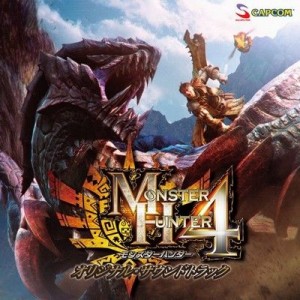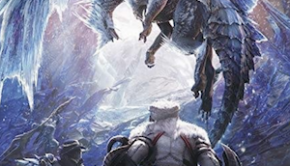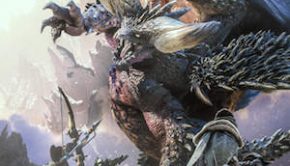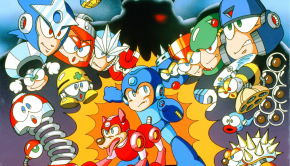Monster Hunter 4 Original Soundtrack
 |
Album Title: Monster Hunter 4 Original Soundtrack |
| Record Label: Suleputer |
|
| Catalog No.: CPCA-10322/3 |
|
| Release Date: November 20, 2013 |
|
| Purchase: Buy at CDJapan |
Overview
The fourth installment of the Monster Hunter franchise has been met with very positive responses from users and critics alike since its 2013 release. The music of the series has been popular since the first game’s soundtrack, and has generated several arranged albums, music collections, and covers celebrating the rich area and battle themes of Monster Hunter. The score to Monster Hunter 4, composed by Marika Suzuki, Miwako Chinone, and Reo Uratani, with reprises from Masato Kouda, contains a mix of those trademark monster fighting themes alongside some catchy area themes, resulting in a colorful collection of tracks to a strong score.
Body
The album begins with the bright “Monster Hunter 4 Theme,” opening slowly but quickly building into a triumphant opening theme, and continually evolving into new phrases, almost roving, before settling in almost two minutes into the piece with a finite theme. Once the theme arrives, its significance is conclusive, and repeats once before the piece ends. The theme is a solid one, bringing a full orchestra, and alternating between a sweeping half-step pattern and a staccato march. The piece is a strong opening to the album, and while it sees – for the most part – only faint realizations throughout the rest of the soundtrack, it establishes the beginning of another successful Monster Hunter score in the series. It does return in an almost identical setting in “Winds of Departure,” (minus the introduction), but not through any type of variation or significant arrangement.
“Shaking up the Wagon” heavily incorporates the use of pitched percussion for a sort of plinky sound, letting the listener know immediately that this score is a complete and varied one. Early on in the track, “Shaking up the Wagon” refuses to stick to the heavy, dramatic theme presented in both the opening piece and the several pulse-pounding battle themes that permeate the track. The piece is ambling, slightly doleful, and meandering, with the percussion in several unusual sounds for a streamlined melody against the backdrop of assorted percussive elements.
Several of the pieces on the album follow in the vein of “Shaking up the Wagon,” in terms of ostensible simplicity and delightfully mild whimsy. “A Stirring Chest” has a strong, lyrical melody on an Eastern pipe, against a steady percussive bass rhythm and plucked strings. While the melody is unquestionably prominent, it’s also a simple one, relying on a series of notes half-and-whole steps apart from each other on the scale and common jumps. “Ancient Shards” is another such piece in terms of its light, almost amused, nature, with a mix of plucked strings and wooden and metallic percussion; however, “Ancient Shards” does not have a prominent melody line. The melody is not played on a separate instrument above the percussion, but instead embedded in the pitched percussion that makes up the fibers of “Ancient Shards.” “A Village Swaying in the Wind – Shinato” uses a series of pipes and guitars to create a similar effect but more melancholy and pensive in comparison to the quirkiness of the previous pieces. Instead of pitched percussion, the harmony is grounded in a rural acoustic guitar pattern, half arpeggios and half counterpoint, giving the musical semblances of a quiet little acoustic band improvising a well-known tune. The rhythm is there, but not forced or even emphasized – it’s simply implied as the guitar continues its little pattern alongside the alternating pipes and their wistful melody.
“A Highly Vibrating Chest” uses a slew of arpeggios in low brass to create a slow-moving but solid piece, with a barely discernible melody moving gently across the arpeggios with a murky blend of horns and strings. In some ways, the melody is nothing more than a voicing of the chords represented in the arpeggios, but through occasional subdivisions and reliance on the bass’s syncopations the melody very subtly separates itself from the rolling bass notes. “Hunter of the Loving Overtones” is a musically appropriate piece, bringing a set of bells and pitched percussion to the melody and subsequently including the titular overtones. The harmonics are structured in such a way that the overtones, so often frantically avoided in any orchestral setting, are embraced by the rest of the chords. Bells are powerful instruments in large part because of their overtones, certainly difficult to use in composition (outside of bell choirs), and while too many bells can absolutely become too overwhelming, I enjoy seeing composers tackle these instruments. “Hunter of the Loving Overtones” uses the mezzo-piano bells for a slightly ethereal but digestible series of clashing overtones and an otherworldy – and altogether positive – effect.
Some of the tracks of Monster Hunter are short, ranging around (or under) a minute in length. “Don’t Say Goodbye” is one such piece, clocking in at 1:08; the music-box-styled theme is both unusually melodic and unusually rhythmically standard. The piece is surprisingly sweet and songlike, almost like a lullaby, and not just in terms of instrumentation, but in terms of its lyrical structure and stepwise pattern of notes. “Enjoy This” is a Caribbean spin on the Monster Hunter Main Theme, just under 1:20, with a complex combination of light percussion (including some kind of copycat steel drum) contrasting a simple solo pipe. The melody is a minimalist version of the main theme, playing primarily the two notes a half-step apart that conjure up the main theme with minimal effort. The quality of these tracks is high, but perhaps suffers due to its length – it would have been wonderful to hear more of these themes woven into other tracks more prominently.
The casual, tropical tracks of Monster Hunter are not limited to minute-long snippets, and in fact they give the album a strong sense of diversity that contrast with the more prominent and iconic battle themes. “Gather, Everyone! – Poka Poka Isle” is a thoroughly charming little area theme using very light wooden percussion – including a rainmaker – plucked strings, and a flute on top of it all. The plucked strings – which in this track leans more towards guitars rather than pizzicato strings – play a delightful arpeggio as a part of their harmonic motif which, due to the lightness of the piece as a whole, resembles a melody in a few areas.
“Song of One” deserves special mention as a particularly enchanting track, featuring a gorgeous combination of arco strings, guitar, and women’s chorus (along with a soloist). This track was a stand-out song in terms of its uniqueness within the album, sounding like a leaf out of Yuki Kajiura’s Noir due to its prominent harmonies and instrumentations. Despite the song’s melody, the harmony provided by the additional vocals serves a significant role in the piece’s overall effect as a contemporary, even distorted, hymn. I absolutely loved this piece from the moment I heard it – not only does it bring it a completely unused type of vocals in an album that rarely incorporates vocals, but it is extremely well composed and executed, giving it a distinct sound that separates it from the rest of the album.
Of course, it would not be a true Monster Hunter soundtrack without its slew of monster hunting themes. “Golden Reminiscence – Kechawacha” is one of my favorite of these themes, taking a very liberal variation of the “Monster Hunter 4 Theme” and pumping it with a percussion in the form of a rhythmic motif. I love the melody of this theme, which is unusually pensive for its role in the score. The slew of battle themes on this score work only because of the differentiation between each theme, and this one has what is perhaps the strongest melody, based loosely on the harmonic structure of the game’s main theme.
“Fangs Lurking on the Surface of the Ice,” uses a series of bright flashes of sound before a percussive blow quickly begins a quick pattern of cellos running up and down some notes of a minor scale. The dark whirlpool of low strings is broken by arpeggios rising and falling in the treble clef and transient piano flurries that give the piece a high point that it returns to once a loop. “The Cloak that Conceals the Light – Gore Magala” is another stand-out piece, but for a different reason – the piece depends on heavy, low brass for its melody and percussion. While the brass is constantly accompanied by high string patterns that shift each time the piece reaches a new section, it is the brass that holds down the piece and provides a strong anchor to the more unpredictable strings.
Even less influenced and supported by the treble clef, “Raging Magma – Gravios” is a piece full of pounding percussion and brass, and only very subtly reaching an alto clef through a gentle, humming string tremolo. The soundtracks to Monster Hunter are no stranger to heavy percussive elements, and this soundtrack falls right into that camp. “Meandering Melody – Garara Ajara” is one such piece which, interesting, does not have a strong melody at all, but instead a wandering series of plucked strings, pipes, and wooden pitched percussion that gives the piece a jungle feel. Occasionally some arco strings fall in sync with the percussion for a very brief series of notes to create a skeletal melody, but the percussion quickly picks up its own pace again and leave the melody to meander accordingly.
One of the most successful monster fighting tracks is “Brave Icon – Brachydios,” a powerful and driving piece with a bright little string-and-percussion opening that develops into a strangely metered but linear melody. The combination of the straightforward melody and heavy percussive rhythms is enthralling and downright fun, and while eventually the brass winds up with a more conventional melody, the strings never really give way, keeping the piece carefully balanced between strings and brass, and allowing both sections equal weight on the melody (with the strings only taking over through their far more intricate harmonic patterns). Strong battle themes are not only pulse-pounding and driving in battle, but iconic outside of battle, catchy enough to bring back memories of the battle without the game’s images, and “Brave Icon” is one of those tracks.
Summary
The number of times I found myself wanting to use the word “unique” to describe a piece on this album goes to show how varied the score truly is. Unlike many sprawling soundtrack projects, there is no real rut that the album seems to fall into in terms of its repetitiveness, which is perhaps due, in part, to the collaboration of multiple composers on the project. The issue that occasionally arises with these types of collaborations is a lack of continuity or cohesiveness to the album, but enough of the themes resurface, if tenuously, to create a unified work. If I had to had a major qualm with the score, it’s that out of the 63 tracks of the game, 19 of those tracks are under 1:00, and an additional six tracks fail to pass the 1:30 mark, which gives the entire album a much shorter run time than it might originally appear based on the track listing. Those longer tracks, however, are wonderful additions to the Monster Hunter music franchise, and several of these tracks, along with a few of the battle themes in particular contribute to the overall quality of the signature hunting music series of the games.
Do you agree with the review and score? Let us know in the comments below!
4.5
Posted on May 21, 2015 by Emily McMillan. Last modified on May 21, 2015.














